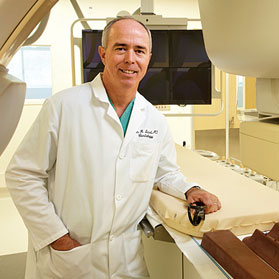Research on stem cells to reduce amputation rate
Researchers working at UC Davis Vascular Center, have embarked on a highly feasible study, involving the use of the patient's own stem cells to increase blood circulation to the shin In the hope of not needing amputation surgery for patients with diabetes or severe arterial disease.

' Losing a limb is a serious complication of severe vascular disease ,' said John Laird, director of the UC Davis Vascular center and responsible for the study. ' We are committed to finding alternatives to amputation surgery, while still ensuring life saving and improving the quality of life for patients with vascular disease .'
According to estimates each year in the United States, about 85,000 patients undergo amputation surgery in the United States, a consequence of severe atherosclerosis, also known as acute ischemia - but where the accumulation of fat, calcium and plaque in the arteries significantly reduces blood flow to the lower limbs. Current treatments for congestion include balloon angioplasty, strengthening weakened arteries with metal stents or bypassing damaged arteries by static grafting. circuit. When the disease progresses to the point of threatening ischemia and when these measures are not feasible, amputation surgery becomes the only option.
' Many patients are amputated because of treatments such as opening arteries with balloon or venous graft surgery that cannot be done or have no results ', according to John Laird. ' Stem cell therapy can provide new effective treatments for increasing blood circulation, for desperate patients with the decision to cut off spending .'
This study involves a surgical procedure that takes place in two hours, in which bone marrow is harvested from the pelvis and rotated in a centrifuge to separate mononuclear cells. These cells include white blood cells and mononuclear stem cells that contain concentrations of the endothelial cells - the original cells responsible for forming blood vessels in the uterus. The stem cells are separated, then injected into the muscles of the legs at risk of amputation at many points. These stem cells have also been tested for quality and sterility at UC Davis' new production facility, which is funded by the California Institute of Regenerative Medicine (CIRM).
' Hope is what these cells did in the early stages of life can be, repeated, many times later in life by producing new blood vessels, breaking blood vessels. was completely damaged ', according to John Laird.

The whole process of treatment, requires a rigorous process to take place in the standard operating room and patients may feel a little uncomfortable at least. Patients still have to be monitored during night hospital treatment and will periodically return to the UC Davis circuit center in Sacramento California, USA, for a series of 5 follow-up treatments throughout the year.
Experimental sponsors, Biomet Biologics of Warsaw, Ind., Produces specialized devices - called MarrowStim ™ - that are used to extract bone marrow blood cells along with high-speed, desktop centrifuges. separating and concentrating mononuclear cells, making it easy to provide them for therapeutic goals. The company has just completed Phase I of this technology's safety research, and this result has been used to refine the technology and launch new tests, which have been approved by the US Food and Drug Administration. period (FDA) approved.
The study initiated the stem cell research program of UC Davis Vascular Center, currently being tested only on the West Coast site. UC Davis was selected to participate in this study because of its research expertise in vascular and bone marrow, in addition to the resources of UC Davis regeneration treatment institute, where the research team A research-driven approach promotes scientific discoveries to make a breakthrough in stem cell therapy.
' Research in mice has shown that in adults, human stem cells are very effective at treating areas with low oxygen levels, and this also promotes the formation of new blood vessels ', according to Jan Nolta, director of the UC Davis Stem Cell program and the Regenerative Treatment Institute. ' The next phase of our study will determine: whether the patient's own stem cell use actually provides hope for those without other options and those at risk of losing one leg. . '
Laird and Nolta carefully planned their research with a team of surgeons, researchers, nurses and laboratory experts from the Regenerative Treatment Institute and UC Davis Medical Center.
- 10 ways stem cells promote medical development
- Transplanting monkey stem cells successfully cured heart disease
- Stem cells will be taken to the ISS station for observation
- What are stem cells? How advanced is medicine in this area?
- Regenerating stem cells from mouse skin
- It was possible to transplant stem cells from one person to another
- Detecting 'multipurpose' stem cells helps cure many diseases
- Vietnam isolated bone marrow stem cells
- America successfully recreates bones from stem cells
- LEARN ABOUT ORIGINAL CELL (Part 2)
- Successful development of pork from stem cells
- Stem cells - hope to treat cancer
 Green tea cleans teeth better than mouthwash?
Green tea cleans teeth better than mouthwash? Death kiss: This is why you should not let anyone kiss your baby's lips
Death kiss: This is why you should not let anyone kiss your baby's lips What is salmonellosis?
What is salmonellosis? Caution should be exercised when using aloe vera through eating and drinking
Caution should be exercised when using aloe vera through eating and drinking